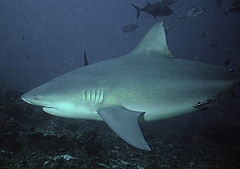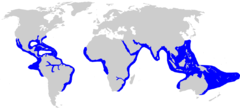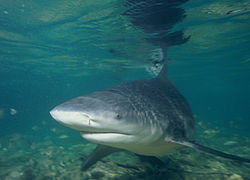- Bull shark
-
Bull shark 
Conservation status Scientific classification Kingdom: Animalia Phylum: Chordate Class: Chondrichthyes Subclass: Elasmobranchii Order: Carcharhiniformes Family: Carcharhinidae Genus: Carcharhinus Species: C. leucas Binomial name Carcharhinus leucas
(J. P. Müller and Henle, 1839)
Range of bull shark The bull shark, Carcharhinus leucas, also known as Zambezi shark or unofficially known as Zambi in Africa and Nicaragua shark in Nicaragua, is a shark common worldwide in warm, shallow waters along coasts and in rivers. The bull shark is well known for its unpredictable, often aggressive behavior.
The Bull shark can thrive in both saltwater and freshwater and can travel far up rivers. They have even been known to travel as far up as Indiana in the Ohio River and Illinois in the Mississippi River, although there have been few recorded attacks. They are probably responsible for the majority of near-shore shark attacks, including many attacks attributed to other species.[2] However, bull sharks are not true freshwater sharks (unlike the river sharks of the genus Glyphis).
Contents
Etymology
The name bull shark comes from the shark's stocky shapes, broad, flat snout and aggressive, unpredictable behavior. [3] In India, the bull shark may be confused with the Sundarbans or Ganges shark. In Africa it is also commonly called the Zambezi River shark or just Zambi. Its wide range and diverse habitats result in many other local names, including Ganges River Shark, Fitzroy Creek Whaler, van Rooyen’s Shark, Lake Nicaragua Shark,[4] river shark, freshwater whaler, estuary whaler, Swan River Whaler,[5] cub shark, and shovelnose shark.[6]
Distribution and habitat
The bull shark lives all over the world in many different areas and travels long distances. It is common in coastal areas of warm oceans, in rivers and lakes, and occasionally salt and freshwater streams if they are deep enough. It is found to a depth of 150 metres (490 ft) but does not usually swim deeper than 30 metres (98 ft).[7] In the Atlantic it is found from Massachusetts to southern Brazil, and from Morocco to Angola. In the Indian Ocean it is found from South Africa to Kenya, India, and Vietnam to Australia.
There are more than 500 bull sharks in the Brisbane River. One was reportedly seen swimming the flooded streets of Brisbane, Queensland, Australia, during the Queensland floods of late 2010/early 2011.[8] Several were sighted in one of the main streets of Goodna, Queensland, Australia, shortly after the peak of the January, 2011, floods.[9] There are greater numbers still in the canals of the Gold Coast, also in Queensland, Australia. A large bull shark was caught in the canals of Scarborough, 2 hours north of the Gold Coast.[10] In the Pacific Ocean, it can be found from Baja California, to Ecuador. The shark has traveled 4,000 kilometres (2,500 mi) up the Amazon River to Iquitos in Peru.[11] It also lives in fresh water Lake Nicaragua, in the Ganges and Brahmaputra rivers of West Bengal and Assam in eastern India and adjoining Bangladesh. It can live in water with a high salt content as in St. Lucia Estuary in South Africa.
After Hurricane Katrina, many bull sharks were sighted in Lake Ponchartrain.[12] Bull sharks have occasionally gone up the Mississippi River as far upstream as Alton, Illinois.[13] They have also been found in the Potomac River in Maryland.[14]
Freshwater tolerance
The bull shark is the best known of 43 species of elasmobranch in ten genera and four families to have been reported in fresh water.[15] Other species that enter rivers include the stingrays (Dasyatidae, Potamotrygonidae and others) and sawfish (Pristidae). Some skates (Rajidae), smooth dogfishes (Triakidae), and sandbar sharks (Carcharhinus plumbeus) regularly enter estuaries. Elasmobranchs' ability to enter fresh water is limited because their blood is normally at least as salty (in terms of osmotic strength) as seawater through the accumulation of urea and trimethylamine oxide, but bull sharks living in fresh water reduce the concentration of these solutes by up to 50%. As a result, bull sharks living in fresh water need to produce twenty times as much urine as those in salt water.[4]
Initially, scientists thought the sharks in Lake Nicaragua belonged to an endemic species, the Lake Nicaragua shark (Carcharhinus nicaraguensis). In 1961, following specimens comparisons, taxonomists synonymized them.[16] They can jump along the rapids of the San Juan River (which connects Lake Nicaragua and the Caribbean Sea), almost like salmon.[17] Bull sharks tagged inside the lake have later been caught in the open ocean (and vice versa), with some taking as little as seven to eleven days to complete the journey.[16]
Anatomy and appearance
Bull sharks are large and stout, with females being larger than males. The bull shark can be up to 81 centimetres (2.66 ft) in length at birth[18] and grow up to 3.5 metres (11 ft) (though a 13-footer was caught in a South African river) and weigh 318 kilograms (700 lb).[19] Bull sharks are wider than other requiem sharks of comparable length, and are grey on top and white below. The second dorsal fin is smaller than the first. Per the Discovery Channel and Animal Planet program Animal Face-Off, bull sharks have a bite force of up to 567 kilograms (1,250 lb).
The bull shark's caudal fin is longer and lower than that of the average shark. It has a small snout. There is a lack of an interdorsal ridge.[18]
Diet
A bull shark's diet consists mainly of bony fish and sharks, including other bull sharks,[20] but can also include turtles, birds, dolphins, terrestrial mammals, crustaceans and echinoderms.[1][21] Bull sharks have been known to use the bump-and-bite technique to attack their prey.
Behavior
Bull sharks are typically solitary hunters,[7] but occasionally hunt in pairs.[citation needed] They often cruise through shallow waters. They can accelerate rapidly and can be highly aggressive, even possibly attacking a racehorse in the Brisbane River in the Australian state of Queensland.[22] They are extremely territorial and attack animals that enter their territory. Since bull sharks often dwell in very shallow waters, they may be more dangerous to humans than any other species of shark[23] and, along with the tiger shark and great white shark, are among the three shark species most likely to attack humans.[3]
One or several bull sharks may have been responsible for the Jersey Shore shark attacks of 1916, which was the inspiration for Peter Benchley's novel Jaws.[24] The speculation of bull sharks possibly being responsible is based on some attacks occurring in brackish and freshwater as well as there being certain similarities in bite marks between bull and great white sharks.
The bull shark is responsible for attacks around the Sydney Harbour inlets.[25] Most of these attacks were previously attributed to great whites. In India bull sharks swim up the Ganges River and have attacked people. Many of these attacks have been attributed to the Ganges shark, Glyphis gangeticus, a critically endangered river shark species that is probably the only other shark in India that can live comfortably in freshwater, although the grey nurse shark was also blamed during the sixties and seventies.
Reproduction
Bull sharks mate during late summer and early autumn,[26] often in the brackish water of river mouths. After gestating for 12 months, a bull shark may give birth to four to ten live young.[26] They are viviparous; they are born live and free-swimming. The young are about 70 cm (27.6 in) at birth and take 10 years to reach maturity. Coastal lagoons, river mouths, and other low-salinity estuaries are common nursery habitats.[27]
Ecology
Bull sharks are apex predators and rarely have to fear being attacked by other animals. Humans are their biggest threat. Larger sharks, such as the tiger shark and great white shark, may attack them.[2] There have been stories documented in the media of saltwater crocodiles preying on young bull sharks in the rivers and estuaries of Northern Australia.[28]
See also
- Outline of sharks
- List of sharks
- List of fatal, unprovoked shark attacks in the United States by decade
Notes and references
- ^ a b "Carcharhinus leucas". IUCN Red List of Threatened Species. Version 2011.1. International Union for Conservation of Nature. 2005. http://www.iucnredlist.org/apps/redlist/details/39372. Retrieved 18 August 2011.
- ^ a b "Bull shark". Florida Museum of Natural History. http://www.flmnh.ufl.edu/fish/Gallery/Descript/bullshark/bullshark.htm. Retrieved 2006-09-08.
- ^ a b "Bull shark". National Geographic. http://animals.nationalgeographic.com/animals/fish/bull-shark.html. Retrieved 2011-04-3.
- ^ a b "Biology of Sharks and Rays". ReefQuest Centre for Shark Research. http://www.elasmo-research.org/education/ecology/fresh-bull.htm. Retrieved 2010-08-19.
- ^ Mark McGrouther (12 May 2010). "Bull Shark, Carcharhinus leucas Valenciennes, 1839 - Australian Museum". Australian Museum. http://australianmuseum.net.au/Bull-Shark-Carcharhinus-leucas-Valenciennes-1839. Retrieved 2010-08-19.
- ^ Allen, Thomas B. (1999). The Shark Almanac. New York: The Lyons Press. ISBN 1-55821-582-4.
- ^ a b "Carcharhinus leucas". University of Michigan Museum of Zoology, Animal Diversity Web. http://animaldiversity.ummz.umich.edu/site/accounts/information/Carcharhinus_leucas.html. Retrieved 2006-09-08.
- ^ "Queensland rebuilding 'huge task'". BBC News. 2011-01-12. http://www.bbc.co.uk/news/world-asia-pacific-12169218.
- ^ http://www.dailyexaminer.com.au/story/2011/01/14/ipswich-bull-sharks-spotted-flood-affected-streets/
- ^ Berrett, Nick (2008-11-14). "Canal shark shock". Redcliffe & Bayside Herald. Quest Community Newspapers. http://redcliffe-and-bayside-herald.whereilive.com.au/news/story/canal-shark-shock/. Retrieved 2009-03-26.
- ^ Bull shark (Carcharhinus leucas)
- ^ High number of sharks reported in Lake Pontchartrain.
- ^ "Sharks in Illinois". In-Fisherman. http://www.in-fisherman.com/content/sharks-illinois. Retrieved 2010-07-26.
- ^ 8-Foot Shark Caught In Potomac River
- ^ Leonard I.V.Compagno, Shark Research Center, South African Museum; Sid F. Cook, Argus-Mariner Consulting Scientists (March 1995). "Freshwater elasmobranchs; a questionable future". Florida Museum of Natural History Ichthyology Department. http://www.flmnh.ufl.edu/fish/organizations/ssg/sharknews/sn3/shark3news6.htm. Retrieved 2011-04-27.
- ^ a b Fresh Waters: Unexpected Haunts. elasmo-research.org. Accessed 2008-04-06.
- ^ Crist, R. 2002. Carcharhinus leucas. Animal Diversity Web. Accessed 2008-04-06
- ^ a b Shark Species; Bull Sharks. Shark Diver Mag (issue 17; 2003).
- ^ <http://www.geofishdive.com/shark-info.html>
- ^ "Bull Shark". Florida Museum of Natural History Ichthyology Department. http://www.flmnh.ufl.edu/fish/gallery/descript/bullshark/bullshark.htm. Retrieved 2010-08-18.
- ^ Kindersley, Dorling (2001). Animal. London & New York: Smithsonian Institution.
- ^ "Shark mauls horse in Brisbane River". Sydney Morning Herald. 2005-03-23. http://www.smh.com.au/news/National/Shark-mauls-horse-in-Brisbane-Rivers/2005/03/23/1111525216327.html.
- ^ Crist, R. 2002. "Carcharhinus leucas" (On-line), Animal Diversity Web. Accessed March 12, 2007 at animaldiversity.ummz.umich.edu
- ^ Handwerk, Brian. "Great Whites May Be Taking the Rap for Bull Shark Attacks". National Geographic News. http://news.nationalgeographic.com/news/2002/08/0802_020802_shark.html. Retrieved 2007-02-01.
- ^ Quinn, Ben (15 March 2009). "Shark attacks bring panic to Sydney's shore". The Guardian (London). http://www.guardian.co.uk/world/2009/mar/15/australia-sydney-shark-attacks-race. Retrieved November 2009.
- ^ a b McAuley, R. B.; C. A. Simpfendorfer, G. A. Hyndes, R. C. J. Lenanton (30 January 2007). "Distribution and reproductive biology of the sandbar shark, Carcharhinus plumbeus (Nardo), in Western Australian waters". Mar. Freshwater Res. 58 (1): 116–126. doi:10.1071/MF05234. http://www.publish.csiro.au/view/journals/dsp_journal_fulltext.cfm?nid=126&f=MF05234. Retrieved 2 December 2009. "The proportion of mature males with running spermatozoa increased from 7.1% in October to 79 and 80% in January and March, respectively, suggesting that mating activity peaks during late summer and early autumn."
- ^ <http://www.flmnh.ufl.edu/fish/gallery/descript/bullshark/bullshark.htm>
- ^ "No Bull: Saltwater Crocodile Eats Shark". UnderwaterTimes.com. 2007-08-13. http://www.underwatertimes.com/news.php?article_id=84173256109. Retrieved 2008-06-15.
General references
- "Carcharhinus leucas". Integrated Taxonomic Information System. http://www.itis.gov/servlet/SingleRpt/SingleRpt?search_topic=TSN&search_value=160275. Retrieved 23 January 2006.
- Froese, Rainer, and Daniel Pauly, eds. (2005). "Carcharhinus leucas" in FishBase. 09 2005 version.
- Bull shark, Carcharhinus leucas MarineBio"
- Sunday Herald Sun, Sunday, April 23, 2005
External links
- Bull shark at the Open Directory Project
Categories:- IUCN Red List near threatened species
- Viviparous fish
- Carcharhinidae
Wikimedia Foundation. 2010.



